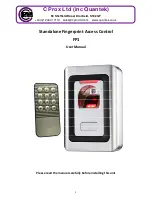
defrost starts. By pressing any button dur-
ing the alarm condition, the signal light dis-
appears. In order to cancel the alarm prop-
erly, you must wait until the next defrost.
EXTERNAL ALARM
The device can also control an external
alarm, i.e. from a digital input. If the digital
input is enabled, the alarm control is acti-
vated by programming and remains
enabled until the next time the digital
input is deactivated. When an alarm is set
off, the fixed alarm icon lights up, the
relay configured as alarm is activated and
the compressor, defrost and fan con-
trollers are deactivated (if specified by the
“EAL” parameter). This alarm condition can
be displayed in the “AL” folder using the
“EA” label. The relay can be silenced; even
if the alarm icon starts blinking, the con-
trollers remain locked until the next time
the digital input is deactivated.
OPEN DOOR ALARM
If a door is open, in response to a delay
defined by the tdO parameter the Open
Door alarm is signalled. The alarm is sig-
nalled by the alarm icon that starts blinking.
This alarm condition can be viewed in the
“AL” folder with the label “Opd”.
LINK ALARM
In the event of a master/slave/echo commu-
nication failure, the NO LINK alarm is sig-
nalled. This alarm condition can be viewed
in the “AL” folder with the label “E7”.
NOTE:
•The E7 error is signalled after approx. 20
seconds in “no link” condition to avoid any
link disturbance causing communication
errors.
•The E7 error is also signalled for address-
ing conflicts when:
a) the number of Slaves set on the MAS-
TER is different from the actual number of
Slaves on the network
b) 2 or more Slaves have the same address.
ELECTRICAL
WIRING
Warning! Always switch off machine
before working on electrical connec-
tions.
The instrument has screw terminals for
connecting electrical cables with a diame-
ter of 2,5 mm
2
max. (only one conductor
per terminal for power connections). for
terminal capacity, see the label on the
instrument.
The relay contacts are voltage free.
Do not exceed the maximum current
allowed.
For higher loads, use a suitable contactor.
Make sure that the power voltage com-
plies with the device voltage.
Probes have no connection polarity and
can be extended using an ordinary bipolar
cable (note that if probes are extended
this affects the electromagnetic compati-
bility (EMC) of the instrument: special care
must be used when wiring).
Probe cables, power supply cables and the
TTL serial cable should be kept separate
from power cables.
INSTALLATION
The unit has been designed to be panel-
mounted. Drill a 29x71 mm hole, insert
the keyboard and fix it in place with the
special brackets provided. Do not assem-
ble the keyboard in excessively dirty
and/or dirty locations because it is
designed to be used in locations with nor-
mal pollution levels.
Always make sure that the area next to the
unit cooling slits is adequately ventilated.
ID 985 LX Fan Condenser
4/11
DISPLAY
AH1
AL1
AH3
AL3
Ad2
EA
Opd
E7
E10
Press any button to silence the alarm. The LED will
start to blink. If simultaneous, they will be showed
on the display alternatively every 2 seconds
*No-link alarms and addressing conflicts alter-
nate with the temperature or probe error val-
ues normally displayed on the Master or Slave.
ALARM
High temperature alarm (referring to
room probe or probe 1)
Low temperature alarm (referring to
room probe or probe 1)
High temperature alarm (referring to
probe 3)
Low temperature alarm (referring to
probe 3)
Defrosting timed out
External alarm
Door Open Alarm
Master-Slave Communication failure
(/CK model)
Clock battery alarm (/C or /CK mod-
els)
Alarm table
,
,
,
,
,





























